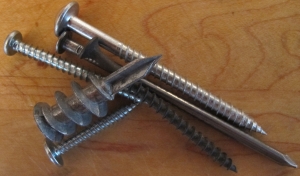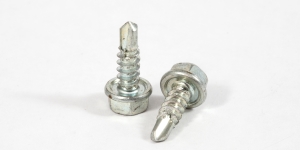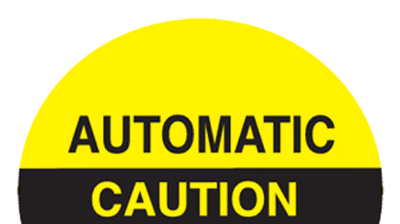Mechanical Fasteners
Download PDF of this article here

By Michael Panish
Expert Witness & Consultant
Mechanical fasteners, when properly used as recommended by the manufacturer, almost always assure safe and secure attachment of a fastened product. In commercial and residential applications, injuries resulting from mechanical attachment failures have often been attributed to inappropriate usage of products, improper installation procedures, or the failure of a poorly manufactured fastening product. When a product becomes disconnected from its point of attachment, serious personal injury can result.
As the retained construction expert witness participating in numerous personal injury claims resulting from loose or falling components in commercial buildings, hotels, hospitals, airports, and housing projects, I have been involved in assessing, analyzing, and determining the reasons for the attachment failures of many types of products.
I have observed, during onsite inspections and investigations, a variety of reasons why products become disconnected from their intended location. Reasons why products become detached and dangerous leading to severe personal injuries include but are not limited to:
- Missing fasteners
- Missing fastener parts
- Inappropriate fasteners for the particular product being attached
- Improper sizing of the fasteners for loads and penetration
- Improper preparation of the attached product
- Missed connections of the fastening hardware (failure of the fastener to anchor into backing or wall studs)
- Poorly designed systems that have failed due to lack of structural integrity
- Over tightened, stripped and abused fasteners
- Damaged and fatigued hardware
- Destroyed fasteners or substrate from repeated attempts to secure the fastener
- Poorly manufactured component parts of the fastener
- Substituted import fasteners in place of specified domestic products
The attachment failures that I have observed are usually the result of one or more recurring problems
In commercial applications such as in a hotel environment, it is not uncommon to have multiple locations using identical products and fastening systems such as in guest rooms or common area hallways. One example of a multiple location installed product would be a guest room headboard. The headboards are usually attached to the headwall with a cleated system. This cleat system is often found loose or detached due to improper anchoring of the original installation hardware. Ornamental art pieces or wall sconces installed along a common corridor become dislodged due to abuse by patrons and or attachment failures occur due to improper usage of wall anchoring hardware. Another example is often seen in hastily or improperly installed door closer hardware. Serious personal injury claims can result from improper preparation of the receptor areas (point of attachment) where stripped, over torqued, or sheared screws ultimately lead to poor or inadequate attachment of the applied hardware products.
A key factor leading to personal injury is the lack of proper maintenance policies and procedures. In many cases, improper maintenance is found to be another prevalent cause of mechanical fastener failures which has resulted in severe injury claims. Maintenance personnel that are untrained or lack the proper tools to perform repairs often make the decision that the needed corrective actions they have taken to make the repairs have been properly completed. In many cases, the corrective maintenance actions actually created a much more dangerous situation, where a once minor problem became a significant factor contributing to a serious personal injury.
There are probably as many different types of mechanical fasteners as there are products that need fastening. Mechanical fasteners can be as simple as a common staple, nut, bolt, nail, or screw. They can be as complicated as a proprietary connection that requires specialized tools to manipulate the connective surfaces. What is most basic to mechanical fasteners is that they must be used appropriately and as designed by the manufacturer of the fastener.
Most fasteners are designed for a specific application. Manufacturers have engineered their products to evaluate the weight of the object being connected, the substrate that the object will ultimately be connected to, the potential for expansion and contraction or movement of the substrate, and what environment the fastener must function within. Types of materials that sub-surfaces are made from affect the performance of any fastener. It is important to have information as to the component makeup of the point of attachment to insure that the fastener chosen will meet the needs of the applied components. Knowledge of the proper use of fasteners is even more critical in harsh environments. Points of connection with acidic substrates or where temperature, moisture or chemical changes are frequent make choosing the proper fastener even more significant.
On a very basic level, the best fastener for your application must include a calculation to hold the desired object with a substantial margin of safety. Installation methods and techniques must be tailored and designed to exceed the possible abuses that can occur to protect the safety of the patrons of an establishment.
For example, my construction company has installed wall hung pictures throughout hotel rooms and hotel common areas. A small ten pound picture and frame properly attached to a wall does not appear to be a major safety hazard. However, in the most basic installation scenario when hanging this example decoration, my crews have utilized a continuous cleated system that works with a cam lock that assures not only the positioning of the picture, but also assures that the picture and frame cannot be removed from the wall.
If that ten pound picture fell off of the wall, or was hanging over a bed in a hotel room and fell off onto a guest while that guest was sleeping, that small picture and frame could create a serious injury. If the ten pound picture and frame was only attached to the wall using a hook and wire such as would be common in a residential application, the hotel would be negligent in the method of attachment by not protecting its patrons from a possible predictable injury.
While using the hanger wire and hook is reasonable and acceptable in a personal residential application, it could be considered negligent and inappropriate in a commercial application. The possibility that an injury could result from the inadvertent movement and detachment of the frame from the wall when the picture was accidentally brushed in normal usage must be foreseen. The planned potential abuse of this example picture and frame when installed with this locking cleat system answers several requirements that any hotel or commercial location should be concerned with.
1. The hotel should be concerned first with the safety of its patrons.
2. The condition and appearance of the hotel room is important to the management of the hotel.
3. The picture is secure from theft by guests.
With the proper usage of a locking cleated fastening system, the example picture and frame are securely attached. Making certain that the artwork remains level and straight, the design element of the room is maintained precisely as planned by the designers for the patrons to enjoy safely.
As a wide range and variety of wall conditions exist, the requirements of safe and proper attachments vary with the site conditions. Fasteners manufactured for almost any kind of wall and substrate exist, however, are often misused leading to personal injuries that could have been prevented. On different personal injury cases, different causes have been determined to have led to fastener failures.

Self-drilling or self-tapping screw and bolts
In many recent cases where products have become detached and fallen upon patrons, a specific type of self- drilling screw system has been used improperly. One advantage of self-tapping, or self-drilling screws is that in certain specific applications, installers take advantage of a one-step attachment. The installer has opted to eliminate the time required to drill and tap a hole using an appropriate sized drill bit followed by creating threads with a tap of some sort that would accept a machine threaded screw. In some applications of products this self-drilling system is acceptable, however, in many applications it is the beginning of an extremely dangerous hidden condition.
When a manufacturer supplies multiple adaptive fasteners with a product, such as a heavy magnetic lock or door closer, that manufacturer is providing a variety of solutions of attachment for an unknown installation condition. Professional installers and service providers that would offer installation of heavy products such as these need to be aware of the site conditions and have adequate information of the potential usage so that appropriate fasteners can be chosen from the provided options of fasteners in the box.
When a professional service provider or contractor makes a decision to use a particular supplied fastener, that fastener must be properly used and applied. When an injury occurs due to attachment failures, the installer becomes the first responsible party in a claim such as this. The company that the installer works for is then also responsible for the negligent action of the improper method of attachment created by the installer. Any project management, prime contractor or inspector generally involved in project oversight are also involved in most of these claims.
Heavy magnetic door lockset fall on office employee:
As an example, a magnetic door lock improperly attached in the vestibule of an office fell upon an employee, causing severe brain trauma to that employee. The incident was captured on video as well as the previous day installation of that product. There was clear evidence that the installer had opted to use self-tapping screws which came with the lock. The installer failed to pre drill any through holes that were required to let the self- tapping screws pass through the attachment plate of the lockset prior to the usage of those self-tapping screws. When the subject lock was examined, it was clear that the self-tapping screws had firmly attached to the mounting plate of the lockset, yet had failed to properly connect to the frame of the door where the lockset was placed. Due to the length of the self-tapping screws used, and the thickness of the lockset mounting plate, it was obvious that the screws were not long enough to gain "purchase" into the door frame. After a few short hours, the magnetic lockset fell off of the door frame, and struck the head, neck and shoulder of the now severely injured plaintiff.
Self-tapping, and self-drilling screws have been used for many years with great results. If properly sized and positioned offer a quick alternative to the slow process of tapping a drilled hole manually. The most important issue with using these fasteners is to know the substrate where they are to be attached. Standard practices mandate that at least two and one half complete rotations of the screw thread should exit the back of the substrate into the point of attachment before bottoming out.
The self-drilling action needs to be performed with skilled hands and appropriate tools. Failure to properly enter the point of attachment can oval or elongate the hole prior to the following screw threads entering the hole. When the following threads do not have adequate connection into the substrate because the pilot hole drilled ahead of the screw threads is larger than the diameter of the screw threads themselves there is no positive sure connection created.
A clear through hole slightly larger than the diameter of the self-tapping screw needs to be drilled prior to positioning a self-tapping screw. This assures that the self-tapping screw does not bottom out or wind into the item being attached prior to gaining penetration into the substrate or point of attachment. In light duty applications, no through drilling is required. A typical light duty application example would be when metal studs are framed using self-tapping screws. As long as the technique used for installation is trade appropriate, the self-drilling action through the stud track will allow the screw to make appropriate connection with the inner positioned stud.
When certain codes require manually drilled and tapped threads, self-tapping screws are not allowed. An example of this non-compliant situation would pertain to ADA panic devices, fire rated hardware, door closers, and heavy overhead products such as the aforementioned magnetic lock devices. Inappropriate usage of undersized self-tapping screws have created injuries due to over-torqueing, shearing of screw heads and failure of the attachment due to metal fatigue. In many metallurgy evaluations of failed fasteners, it has been found that the screw was overstressed during the installation of the product being installed simply because the metal of the point of attachment was far harder than the metal of the tapping screw. Other times failure to monitor the imparted force exerted by the automatic tool twisted the screw past the breaking point. Many modern powered screw drivers have torque limiters or clutches to prevent this overstressing of the screw during installation.
It has been found that improper usage of fasteners has been the result of:
1. Attempting to lower the product installation costs.
2. Architects or engineers have specified inappropriate products for attachment.
3. Architects omit fastening instructions, so installers choose inappropriate fasteners for the product.
4. Installation techniques were wrong for the installed products.
5. Time constraints limited the quality of work, and due to a rushed schedule, hardware and fasteners were omitted by the installation contractors.
6. Incompetent service providers or installers did not understand the proper usage of the fastener, and did not investigate whether the fastener used had accomplished the task at hand (meaning did the screw attach securely to the sub materials, not just into the product that was being installed).
Representing both Plaintiff and Defense in personal injury claims, a variety of entities have been blamed for injuries resulting from improper attachment of installed products. In some large hotel cases, there are multiple tiers of responsibility that begin with poor choices made by an architect, designer or engineer. Contract installers, not questioning the installation requirements, project managers and team evaluators hurrying workmen to complete an installation and the lack of a thorough examination of the site after installation is completed. Finally, maintenance workers, maids or janitors lacking the qualifications to properly evaluate the site conditions on a daily basis fail to alert management that dangerous conditions need repair. In many cases, hidden defective installation practices and/or incorrect verification of proper attachments after the products were installed have led to personal injuries. In some circumstances, the installer is solely responsible, other cases have made the project management, prime contractor or owner of the property the primary responsible party.
When evaluating an injury from the defense perspective, some incident investigations have shown and proven that the abusive actions of a patron created the dangerous conditions leading to the injury. While serious injuries may have resulted to that patron, the actions of the patron sometimes eliminated the obligations of the property owner or management.
Mike Panish is a licensed general contractor in the State of California. He is also a commercial cabinet & millwork contractor experienced in manufacturing and installing architectural products. He has been the retained expert on many cases that have resulted from improper usage of fasteners.
Some of the types of cases where he has been retained to inspect, analyze, and evaluate attachment claims and responsibilities by both plaintiff and defense are as follows:
- Head board detachments in hotel rooms.
- Mirrored surfaces, applied vertically and horizontally.
- Overhead architectural panel systems in private residences (sunrooms and shade awnings).
- Architectural millwork in commercial buildings.
- T-grid ceiling systems in commercial buildings.
- Art work and framed mirrors in hotel rooms and common areas.
- Head trauma cases where casework has fallen on patrons and tenants.
- Door and hardware component detachment and failures.
- Book cases and shelving installation defects in housing tract developments.
- Garage storage shelving units in housing tract and condominium developments.
- Garage door component attachments and failures in residential and commercial properties.
- Kitchen and bathroom cabinet detachment and component failures.
- Guard railings and fencing attachment points.
- Cosmetic concealment in themed attractions such as component attachments for themed restaurants, amusement and entertainment venues.
- Improper installation of permanently attached products in municipal buildings and parks.
- Improper attachment of furnishings and cabinets in residences, hotels and commercial malls, casinos and cruise ships.
Michael Panish is an expert witness, forensic analyst, and consultant in the field of construction. He is licensed in the State of California as a General Building Contractor, Cabinet & Millwork Contractor, Door, Lock & Security Equipment Contractor, Paint & Finish Contractor, and Electrical Contractor. Mr. Panish has over 40 years of hands-on experience in the construction industry. He has been involved in concept designs for Hotels, hospitals, chain stores and franchised retail stores. He has participated in cabinet and millwork defect cases throughout the country. He has been designated as lead expert in the field of cabinets and millwork and has been consultant for both plaintiff and defense. Mr. Panish has provided testimony in construction defect, poor workmanship, product liability, and personal injury cases relating to most construction trades, doors, locks, automatic doors, cabinetry, and custom casework. Mr. Panish has offices in California and the New England area and is available for nationwide consultation, forensic analysis, inspection, report, and testimony. Due to Mikes' diverse background in many construction fields, he has been called in as a more knowledgeable expert witness to replace architects and engineers that were offering theoretical opinions. His real-world working knowledge and personal experiences have made him an incredibly successful and invaluable expert witness for many clients involved in these types of detachment injury claim cases. He has helped achieve high personal injury settlements for Plaintiffs, and significantly limited liability for Defense claims and Insurance settlements throughout the United States.
Published Articles by Michael Panish relating to Cabinetry
CABINETRY & MILLWORK - Defective Design or Defective workmanship? Who is Responsible?
MODULAR CABINET SYSTEMS & RETAIL STORE FIXTURES Injuries from Improper Installation



